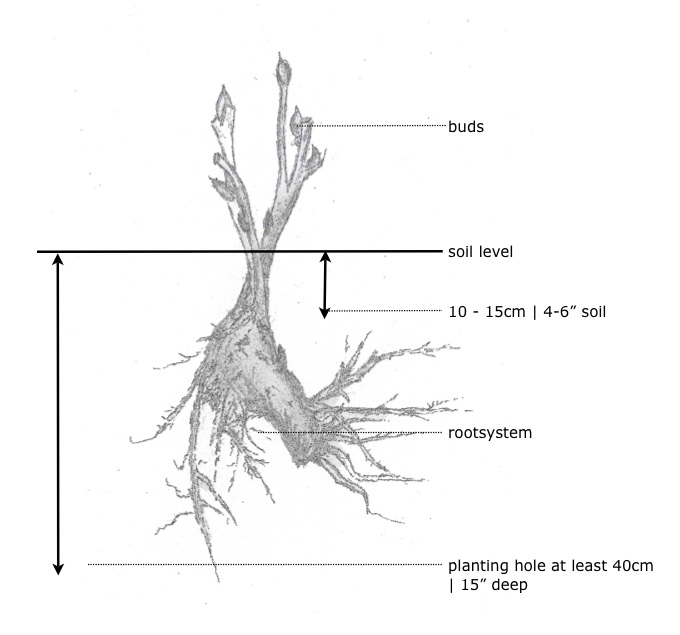
Tree peonies are hardy, temperate climate plants, and need a period of frost to induce flowering the next spring. However, they have the reputation of being more sensitive than herbaceous peonies. While this is partly true, it applies more so to the buds in spring. A tree peony is a grafted plant. A tree peony scion - a small piece of healthy new growth - is grafted onto an herbaceous peony root. The herbaceous root is only used as a starter. The tree peony will eventually produce its own root system. We hope that the hints and tips provided here will help you grow even healthier and stronger peonies next season.
Soil
Well-drained soil is essential. Tree peonies have a finer root system than herbaceous peonies, which develops alongside the herbaceous graft; waterlogged soil does them no good. They grow in most soil types. Additional garden compost worked into sandy and heavy clay soil improves the structure and allows for improved water management and a better nutrition base.
Location
A peony can grow to a very old age: 50 years is not uncommon. Therefore, it is important to select the right location from the start. Avoid the morning sun if possible, as the warmth of the early sun, followed by frost, can damage the opening buds. Always provide sufficient space (1 to 1.5 m) for a large growing variety. Do not plant peonies under trees or shrubs. Competing with established trees and shrubs for light, air, moisture and nutrition is a very exhausting business. Tree peonies thrive in a sunny- or semi-shaded location.
PlantingPlant in sufficiently deep, loosened soil. You'll need to get out that spade! Peonies are greedy; mix extra horn shavings, bone meal and/or a SLOW release fertiliser into the planting hole. In light soils an addition of potash or Kalium fertiliser is appreciated. Do not allow the roots to touch the fertiliser. A tree peony is a grafted plant. It is important for the graft to be located at least 10-15 cm under the soil. A bare root peony is best planted in autumn, so the plant has sufficient time to produce new roots.Peonies in containers can be planted throughout the year, just after flowering has preference. In a very hot summer, planting is best postponed until early autumn. |
 |
Aftercare
Check regularly, especially the first year, that your plant has sufficient water during hot summer days. Water generously once or twice a week, instead of administering small quantities on a daily basis.
Pruning
Pruning can be limited to removing the occasional withered or crossing branches in winter. Wilted flowers may be removed.
Diseases
If your peony shows signs of a fungus attack on the leaves, shoots or flowers, cut out the affected parts and remove these from your garden. Also pick up and remove all the fallen leaves and flowers. If you wish to apply fungicides, several are available in garden centres. Always use as directed. Addressing the cause of the problem, however, should be your first concern. Poorly ventilated surroundings and bad water management should be tackled first.
Pests
No real pests are known. Rabbits and deer have been known to enjoy the occasional tree peony bud. If they are regular visitors, you may want to switch to herbaceous peonies, which appear to be less tasty.
More
At the moment we do not have any tree peonies in our catalogue.
Flowery greetings,
Graefswinning
